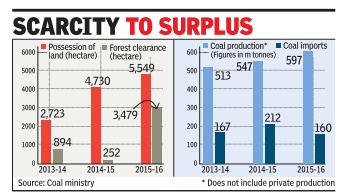Coal India Ltd.
This is a collection of articles archived for the excellence of their content. |
Contents |
Land acquisition
2013-16
The Times of India, Apr 23 2016

Rajeev Deshpande & Sidhartha
India's all-time high coal production of 637 million tonnes hides another feat -acquisition of a staggering 10,000 hectares of land in the past two years for coal projects even as private enterprises complained about hurdles posed by the new land law. Critical factors in a turnaround story that transformed the coal scenario from scarcity to surplus are Coal India's effort to rev-up land acquisition manifold and the public sector company's success in getting stage-II forest clearance for over 3,500 hectares.
As mines go into production, average fuel availability at thermal power generation plants is 27 days, a far cry from the “critical“ and “super critical“ supply scenarios that were the norm in the past. Last year, production grew around 9% on the back of a 6.7% rise in 2014-15 as Coal India and private players mined more coal than ever before.
Coal India's “attractive“ offer of one job for every two acres has helped persuade people to hand over land. As for environment and forest clearances, a change in rules and new electronic-filing and tracking mechanism have helped.
“Faster environment clearances, more land acquisition and quicker evacuation have helped us move swiftly ,“ coal secretary Anil Swarup. He said the key has been increased coordination with states, along with discussions with railways and the environment ministry on fixed days to ensure that stocks are not held up and green approvals are not stuck.
The result is not only much improved power production but a significant fall in imports which, according to official estimates, helped reduce foreign exchange outgo by Rs 28,000 crore. Of course, low plant load factor at power stations has helped reduce some demand for coal. “Given the problem of plenty we are wondering if we should aggressively push the target to achieve 1 billion tonne production by 2020,“ said an official. But the government is going ahead with plans, anticipating a growth spurt.
Starting July, one of three key railway lines, Jharsugu da-Barpali in Odisha, will be operational. Along with two other lines in Jharkhand and Chattisgarh, the coal ministry hopes to evacuate an additional 250-300 million tonnes, setting in on course for the billion-tonne mark.Thanks to railways' joint ventures with states, availability of rakes, a sticking point, has been removed.
The strategy was the familiar carrot and stick. States are told that more mining means higher revenue via royalty . For instance, West Bengal, which was not clearing six blocks for years, was clearly told that some other state will benefit if the mines were shifted, said an official.
And to address concerns, the government is moving to satellite mapping of each mine to monitor afforestation.Similarly , 15 new washeries are being set up to ensure that all coal with less than 34% ash content is cleaned from October 2017.
Apart from production, the focus is also shifting on increasing efficiency . So far, 19 sets of swapping have taken place, which are meant to ensure that coal is made available from a mine, which is closer to the plant, helping generate a savings of Rs 1,300 crore. The target is to raise this to Rs 6,000 crore.
Pollution
November 2017/ Coal India among top 3 CO2 emitters in world
Coal India among top 3 CO2 emitters in world, November 1, 2017: The Times of India
The world's 250 biggest listed companies account for a third of all man-made greenhouse gas emissions yet few have strong goals to limit rising temperatures, a study showed on Tuesday. Coal India, Gazprom and Exxon Mobil topped the list when measuring CO2 emitted by companies and consumers using their products, it said.
“Without continual reduction in emissions from this group of companies, effectively mitigating the long-term risks of climate change is not possible,“ according to the study , a Thomson Reuters Financial & Risk white paper.
In the past three years, emissions from the group of 250 had been flat “when they should have been going down by roughly 3% per year“ to limit temperatures in line with goals set by the 2015 Paris climate agreement, it said.
The report, in collaboration with Constellation Research & Technology , emissions tracking group CDP and BSD Consulting, found the group emitted a third of world carbon emissions and only 30% of the 250 firms had strong goals to cut them.
2016-22: Coal India among top 3 CO2 emitters in world
April 5, 2024: The Times of India
New Delhi: Eighty per cent of global carbon dioxide emissions since the Paris Agreement can be linked to 57 fossil fuel and cement producers in the world where the top three emitters are actually state-owned companies, including Coal India Limited ranked third in the list, shows aanalysis by a London-based think tank InfluenceMap, reports Vishwa Mohan. The other two top emitters during 2016-22 period are state-owned oil firm Saudi Aramco and Russia’s state-owned energy giant Gazprom. The Paris Agreement was unanimously adopted in Dec 2015, seeking countries take voluntary actions to cut down their emissions of climate damaging greenhouse gases.
The analysis using the Carbon Majors database, released on Thursday, reveals such companies produced more fossil fuels in the seven years after Paris Agreement than in the seven years before the Agreement’s adoption.
Carbon Majors is a database of historic production data from 122 of the world’s largest fossil fuel and cement producers. Its analysisshows 70%of global fossil fuel and cement CO2 emissions since the industrial revolution can be traced to 78 corporate and state producing entities.